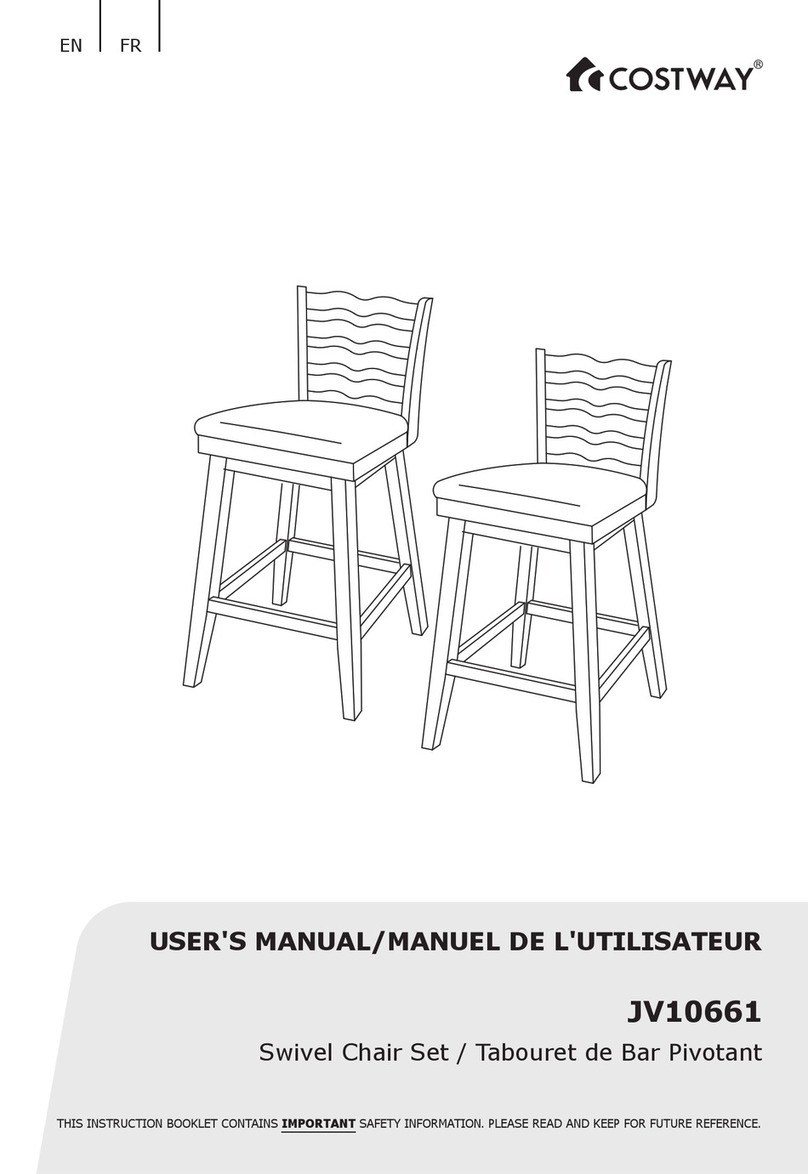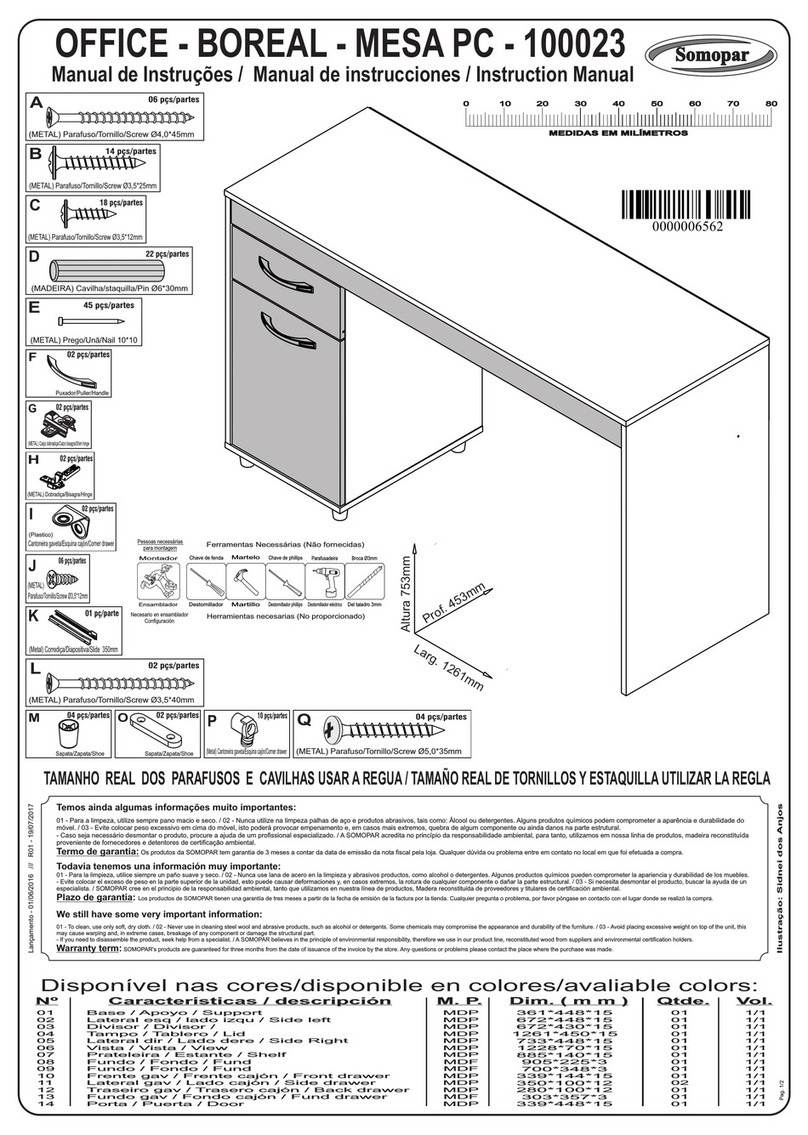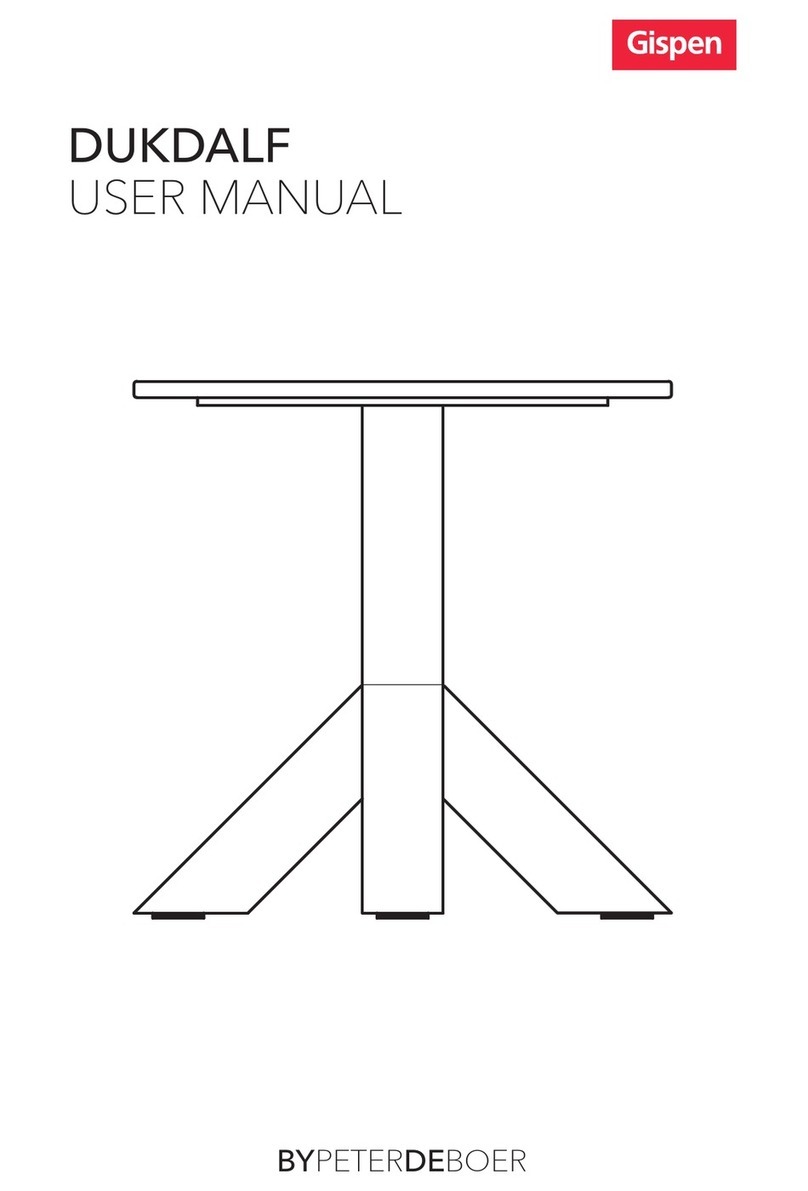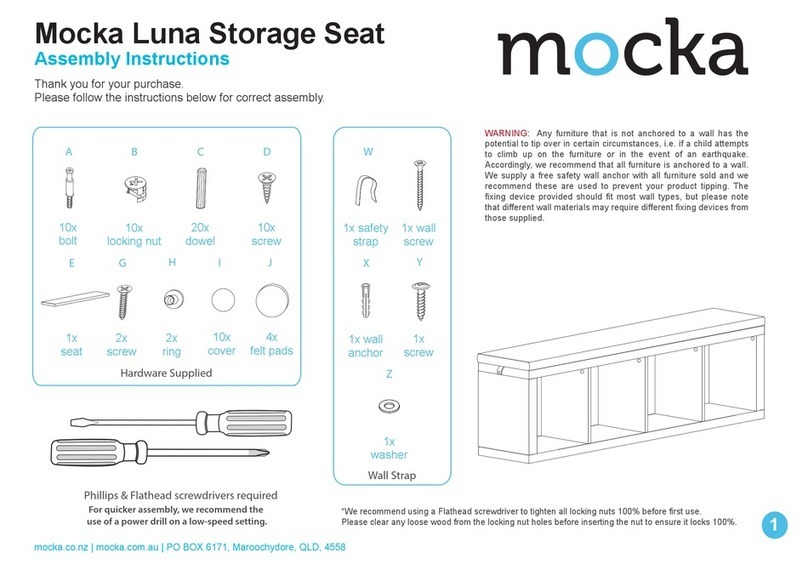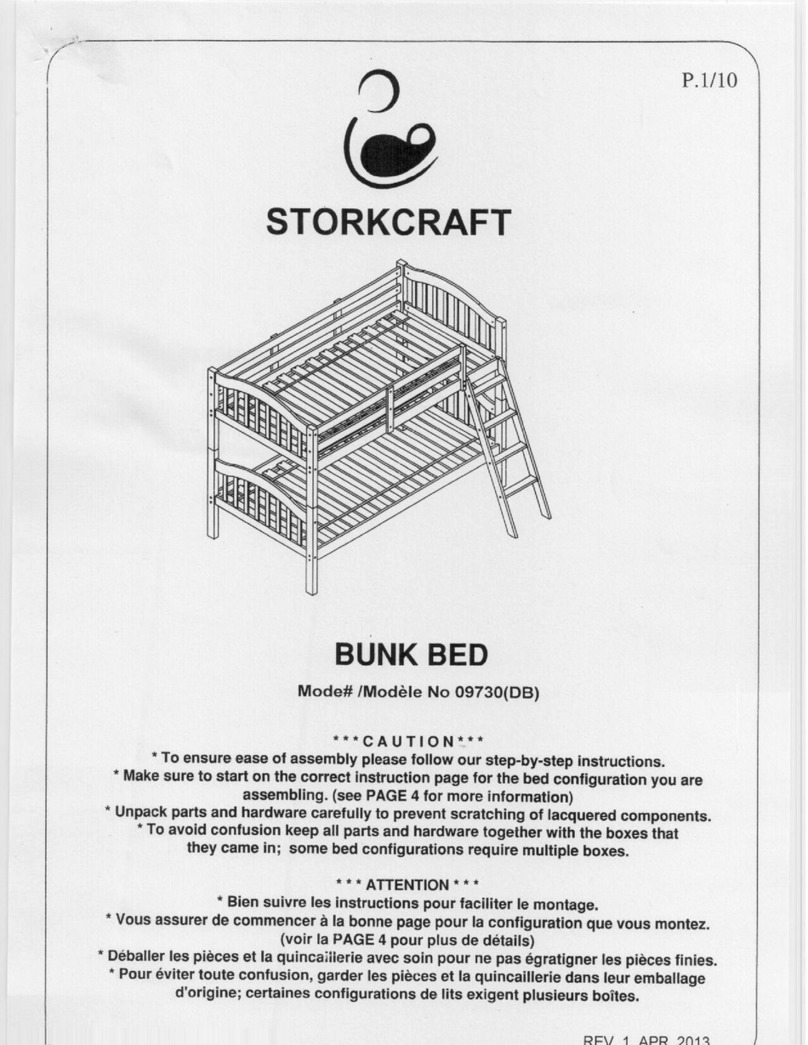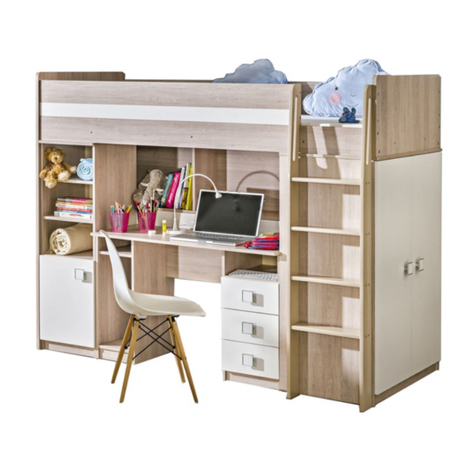Bobe CMP User manual

IMPORTANT SAFETY INFORMATION: READ AND FOLLOW ALL INSTRUCTIONS
Save these instructions. Leave manual with homeowner after installation.
Improper installation, adjustment, alteration, service, or lack of maintenance can cause injury or property damage. Read
the installation, operating, & maintenance instructions thoroughly before installing or servicing this equipment.
FIRE POT / FIRE TABLE
INSTALLATION INSTRUCTIONS - AUTO IGNITION
SAVE THESE INSTRUCTIONS FOR FUTURE REFERENCE
®
Scan with your phone for Step by Step
instructions, or visit www.c-m-p.com/tech

2
Do not store or use gasoline or ammable vapors and liquids in vicinity of this appliance.
Do not install this appliance near any combustibles. A Liquid Propane cylinder not connected for use
shall not be stored in the vicinity of this or any other appliance.
RISK OF SHOCK OR ELECTROCUTION. Hazardous voltage can shock, burn and cause death or serious
property damage.
Installation must be performed by a licensed professional. Improper installation, adjustment, alteration,
service or maintenance can cause injury or property damage. Installer must follow all local codes as well
as National Fuel Gas Code, ANSI Z223.1.
This product must be installed by a licensed or certied electrician or a qualied pool professional in
accordance with the National Electric Code (NEC) or Canadian Electric Code (CEC), CSA C22.1.
Turn o power to controls before installation/service. Failure to comply will either damage or destroy the
product and will void the warranty.
To reduce the risk of injury, do not permit children to use this product.
If you smell gas, shut o the gas to the appliance and extinguish any open ame. If the odor lingers
keep away from appliance and immediately call gas supplier or re department. Do not leave any ame
unsupervised.
Gas pressure should not exceed 1/2 psi.
Carbon Monoxide Hazard: This appliance can produce carbon monoxide which as no odor. Using it in an
enclosed space can cause serious injury or death. Never use this appliance in an enclosed space such as
a camper, tent, car or home.
.
HOT! DO NOT TOUCH. SEVERE BURNS MAY RESULT. CLOTHING IGNITION MAY RESULT.
Glass and other surfaces are hot during operation and cool-down. CAREFULLY SUPERVISE children near
this appliance. Alert children and adults to hazards of high temperatures.
IMPORTANT WARNINGS & SAFETY INSTRUCTIONS
READ AND FOLLOW ALL INSTRUCTIONS
WARNING
WARNING
WARNING
WARNING
WARNING
WARNING
WARNING
CAUTION
CAUTION
CAUTION
DANGER
SAVE THESE INSTRUCTIONS
ADHERE TO ALL LOCAL CODES CONCERNING INSTALLATION AND OPERATION.
• For outdoor use only.
• Product is not intended to be a starter for wood or any other combustibles.
• Test for gas leaks prior to use.
• Verify correct gas fuel type. Never use an alternative fuel, including bio-fuel, ethanol, lighter uid or any other fuel.
• Installation must be performed by licensed gas piping professional.
• When product is not in use for an extended period, turn o gas to prevent unwanted start-up.
• The use of a cover when not in operation is recommended.
• Verify gas shut o is located outside of the product or column. The gas shuto should NOT be used to adjust ame
height.
• An approved gas valve or keyed valve shall be installed upstream of the unit and located in an accessible area that is
within 5ft from the unit.
Do not modify units from factory conguration. Doing so will void the warranty.
Manufacturer is not responsible for damage due to improper installation.
NOTICE

3
B. SYSTEM REQUIREMENTS
Installation must be performed by a licensed contractor. Installer must follow all local codes as well as National Fuel Gas
Code, ANSI Z223.1. We suggest that our products be serviced annually by a professional certied in the US by the National
Fireplace Institute (NFI) as NFI Gas Specialists or in Canada by WETT (Wood Energy Technical Training). Installer must follow all
instructions carefully to ensure proper performance and safety.
NOTICE
This Product is for outdoor use only.
GAS REQUIREMENTS
REQUIRED GAS PRESSURE
DESCRIPTION WATER COLUMN
LIQUID PROPANE 10"WC
NATURAL GAS 3.5"WC
Input pressure should not exceed 1/2 psi
Note: check with your gas supplier to verify
gas ows and pressures available at the
location of your installation. In many cases
utility companies will install larger meters at no
charge to accommodate larger ows.
PERFECT FLAME™FIRE LINE
BURNER SIZE BTUS
IN K’S
FIRE LINE -24” 40
FIRE LINE -29” 50
FIRE LINE -35” 55
FIRE LINE -48” 70
FIRE LINE -61” 80
FIRE LINE -74” 85
FIRE LINE -87” 95
FIRE LINE -100” 105
FIRE LINE -113” 115
FIRE LINE -126” 150
FIRE LINE -134” 175
FIRE LINE -146” 185
PERFECT FLAME™FIRE RING
BURNER SIZE BTUS
IN K’S
FIRE RING - 9” 50
FIRE RING -16” 120
FIRE RING -22” 175
FIRE RING -29” 230
FIRE RING -35” 240
FIRE RING -42” 270
ELECTRICAL REQUIREMENTS
• Auto ignition requires 12 VAC
• The included transformer steps down from 120 VAC to 12VAC
• Installer should check voltage after installation to ensure proper values
• In the United States the National Electrical Code® (NEC®) and in Canada the Canadian Electrical Code (CEC), require that
all metallic components of a pool structure, including reinforcing steel, metal ttings and above ground components be
bonded together (forming an equipotential bonding grid) with a solid copper conductor not smaller than an 8 AWG (6
AWG in Canada).
• To prevent premature failure of the appliance resulting from stray voltages and voltage dierentials, the burner must be
bonded to other equipment which is part of the pool plumbing system with a solid copper wire not smaller in diameter
than 8 AWG (6 AWG in Canada).
• The National Electrical Code® (NEC) allows listed low-voltage gas-red lumiaires, decorative replaces, re pits and
similar equipment using low voltage igniters that do not require grounding, and are supplied by a listed transformer /
power supply with outputs that do not exceed the low-voltage contact limit (15 V RMS ac, 30 V continuous DC) to be
permitted to be located less that 1.5m (5ft) from the inside walls of the pool.
• Metallic equipment, including metallic gas piping, shall be bonded in accordance with the NEC in the US, and Canadian
Electrical Code (CEC) in Canada.
• In the NEC and CEC require that all metallic components of a pool structure, including reinforcing steel, metal ttings and
above ground components be bonded together (forming an equipotential bonding grid) with a solid copper conductor
not smaller than an 8 AWG (6 AWG in Canada)

4
A. FIRE POT/TABLE INSTALLATION
1. LOCATION
DRAINAGE
• Fire pot/tables should have adequate drainage for rainwater. Select a location with adequate drainage. Install above
grade to prevent water retention.
ACCESS
• Leave easy adequate access for installation and maintenance.
• To safely turn o the burner, you must have clear and easy access to the ON / OFF valve AFTER the appliance is
connected to the gas supply.
CLEARANCE
• Recommended Clearances: Sides 4 ft / Top 10 ft: Combustibles/structures not to be closer than 4’ on the horizontal
plane, 10’ overhead. (FIG 1).
• No combustible structure should be above the re feature.
• Do not completely enclose. No more than two side structures should be around the re feature.
• Do not recess the re feature below ground/oor level.
• Natural stone such as granite or marble must be kept away from heat and ame. Contact and close proximity can
result in cracking or explosion.
• Install re features out of the way of pedestrian trac. Provide space to allow a safe distance from the heat and ame.
• Vent collars and drainage should never be obstructed.
10ft
4ft 4ft
OUTDOOR
USE ONLY FLAMMABLE
OR COMBUSTABLE
ITEMS
FIGURE 1: Adequate Clearance
2. SETUP
DRAINAGE
• For natural gas only, a dedicated drain line may be installed under the pot/table.
• Installations using propane should not have drains located below the unit. Drainage should be achieved with vent
holes in the product and/or around the column.
VENTING
• WARNING: All installations must have proper ventilation around and under the unit to allow possible accumulated gas
to escape. Failure to do so may cause a dangerous build-up of gas and can explode.
• Ventilation location must be such that any settled gas can escape.
• Vents are pre-installed in the re pot and table. If installing on an open column or pedestal, ventilation must be added
to prevent dangerous gas build-up.

5
A. FIRE POT/TABLE INSTALLATION
• The top of a column or pedestal on which re feature is installed should be sealed around.
• A minimum of two vents on opposing sides of a column are required. See Table 1 for minimum vent requirements.
Multiple vents evenly spaced totaling minimum requirement or more is also acceptable. Minimum air openings shall
not be less than 3 inches.
• One vent should be within 12 inches of the bottom of the column and another within 12 inches from the top of the
column.
• Vents should not be blocked from air circulation.
VENTILATION OPENING SIZE
BURNER SIZE BTUS
IN K’S
MINIMUM VENT SIZE
EACH TWO REQUIRED
FIRE RING -9” 50 12.5in2
FIRE RING -16” 120 30in2
FIRE RING -22” 175 43.8in2
FIRE RING -29” 230 57.5in2
FIRE RING -35” 240 60in2
FIRE RING -42” 270 67.5in2
FIRE LINE -24” 40 10in2
FIRE LINE -29” 50 12.5in2
FIRE LINE -35” 55 13.8in2
FIRE LINE -48” 70 17.5in2
FIRE LINE -61” 80 20in2
FIRE LINE -74” 85 21.3in2
FIRE LINE -87” 95 23.8in2
FIRE LINE -100” 105 26.3in2
FIRE LINE -113” 115 28.8in2
FIRE LINE -126” 150 37.5in2
FIRE LINE -134” 175 43.8in2
FIRE LINE -146” 185 46.3in2
AIR MIXER FOR PROPANE UNITS
BURNER SIZE AIR MIXER P/N AIR MIXER BTUS
FIRE RING -9” 8-1392-01 50K
FIRE RING -16” 8-1450-01 120K
FIRE RING -22” 8-1451-01 175K
FIRE RING -29”
8-1453-01 240K
FIRE RING -35”
FIRE RING -42” 8-1454-01 270K
FIRE LINE -24”
8-1392-01 50KFIRE LINE -29”
FIRE LINE -35”
FIRE LINE -48”
8-1459-01 85KFIRE LINE -61”
FIRE LINE -74”
FIRE LINE -87”
8-1450-01 120KFIRE LINE -100”
FIRE LINE -113”
FIRE LINE -126”
8-1459-01 170K ( 2 ×85K)
FIRE LINE -134”
FIRE LINE -146”
TABLE 1: COLUMN VENT REQUIREMENT
3. GAS LINE
• To eliminate unnecessary pressure drop, ensure the pipe length and amount of elbows used is minimized.
• Corrugated ex hoses are known to cause a whistling sound. A whistle-free hose is recommended for gas supply to
the burner.
• You must have clear and easy access to the ON / OFF valve AFTER the appliance is installed and connected to the gas
supply in order to safely turn o the burner.
• Openings from the gas/water line should be sealed, so that gas does not collect in these spaces.
• For gas pressure and BTU requirements see charts on page 3.

6
1. AUTO IGNITION COMPONENTS
• All gas and electrical connections are on the box.
• Transformer: 120VAC to 12 VAC transformer is included.
• Pilot Connections: Probes connect to the side of the box to the SS burner and spark electrode. There is a dedicated
gas line pre-installed for the pilot ame.
• Other Items
• Air mixer: Pre-installed with Liquid Propane units
• Flow restricter: Pre-installed with Natural Gas units
• Gas ow regulator: Pre-installed with 18in exible gas line
• Shut-o valve: Not included
Burner
Ceramic
Heat Shield
Spark
Igniter Air Mixer (LP)
Flow Restricter (NG)
Igniter
Power
Pilot Gas
1/2in Gas
Connection
Gas Line
Pressure
Regulator
Shutoff
Valve
Bonding
Lug
12VAC Power
from Transformer
Connection
to 12VAC
FIGURE 1: COMPLETE AUTO IGNITION SYSTEM
2. IMPORTANT INFORMATION FOR PROPANE UNITS
• Air mixers required for Liquid Propane. For propane units, the correct air mixer should come pre-installed.
• Do not attempt to move, adjust or remove the air mixer for LP units. Failure to do so could result in personal injury
and damage to unit/property.
• Vent collars for an air mixer intake on a propane system should not be obstructed.
• Our units are NOT intended to be used with small portable LP tanks.
B. AUTO IGNITION INSTALLATION

7
B. AUTO IGNITION INSTALLATION
3. GAS CONNECTION
a. Before beginning, ensure the gas line is turned OFF.
b. Run 1/2” gas line to the inlet connection of the pre-installed regulator.
• Each unit ships with a regulator pre-installed. All installations must have gas regulator installed to maintain the
gas pressure to the system.
• The regulator should be installed horizontally. The directional arrow should point away from the gas source and
towards the gas valve.
• Gas regulator should be placed near the bottom of the re feature such that it is not aected by temperature
from the burner.
c. Use pipe dope/joint compound on ALL threaded ttings EXCEPT ared ttings.
d. Verify all gas connections are tightened securely. ALWAYS perform leak tests and make repairs as needed.
e. DO NOT daisy chain the gas lines. (See Section D)
f. A shut-o valve must be installed at each re feature or valve. The primary gas valve must be located where they can
be easily accessible so that the gas can be shut o quickly in case of an emergency.
g. Keep pipe length and elbows to a minimum to eliminate unnecessary pressure drops.
h. The use of a corrugated gas line can cause unwanted noise.
4. ELECTRICAL CONNECTION
a. Power Requirements
1. Auto ignition requires minimum 12 VAC
2. The included transformer steps down from 120 VAC to 12VAC.
3. Installer should check voltage after installation to ensure proper values.
4. Max length of wire from the transformer to system is up to 75ft with 16 Gauge wire.
5. For distances over 75ft - 150ft use 14 Gauge wire.
b. Connections (Fig 2)
1. Run electrical cable through an approved conduit. Conduit should be sealed to prevent gas settling or intrusion.
2. Connect 120V to the included or approved Pool & Spa Rated Class 2 transformer (T).
3. There are three wire connections on the side of the auto igniter. Connect 12V power from the transformer using
wire nuts (3).
4. Wrap wire nuts with electrical tape or use waterproof wire nuts to prevent moisture from getting in. Make sure
wire nuts are positioned away from the bottom of the burner assembly.
5. Connect ground from incoming power. (If required by local codes)
6. Do not “daisy chain” electrical lines. (See Section D). Each transformer can supply up to four auto ignitor
connections.
7. The igniter contains a bonding lug on the bottom. To install, loosen the set screw, insert the bond wire into the
hole and tighten the setscrew until the bond wire is secured into place.

8
B. AUTO IGNITION INSTALLATION
BURNER
X1 BLACK
X2 ORANGE
X1 BLACK
120V BLACK
X2 ORANGE
GREEN / GROUND
TRANSFORMER
120V WHITE
GREEN
FIGURE 2: WIRING DIAGRAM
4. CHECK SYSTEM
a. Perform all above listed safety checks before start up. Before operating smell all around the appliance area for gas
odors and next to the oor because some gases are heavier than air and will settle on the oor.
b. Ensure any person standing close to the re feature is aware you will be turning the re feature on prior to actually
turning it on.
c. Do not add glass or rock media to the pan until a system test is complete.
d. At each burner assembly, check that the spark electrode is arcing from the pilot to the button. You should be able to
hear and see the electrode spark. If there is no spark, make sure that the burner assembly is receiving 12VAC from the
control panel.
e. Allow the unit to run for approximately ve minutes then turn o.
f. After all units have been lit, they can be adjusted for ame size.
g. Turn on system and check for re-ignition.

9
C. OPERATION & MAINTENANCE
1. GLASS OR ROCK FILL MEDIA
• Use only approved re glass or rock media on burners. Incorrect media can melt or explode leading to bodily injury
or product damage.
• Glass media max level: ll up to 1/4in above the burner height.
• For glass or rock ll media, leave an airow gap around the ventilation slots for the pilot light box.
Max Glass Media
Airflow GapPilot
FIGURE 3: MEDIA PLACEMENT
2. BURNER SETUP
• Prior to turning appliance on visually inspect re feature to ensure debris such as leaves or other combustible
material has not collected inside the feature. This could burn and emit embers once the re feature is turned on.
• Each burner should have a ame height of approximately 12” – 15” from the top of the pan.
• Each burner should be adjusted as required so that the ame size at each burner is similar in appearance to each
other.
• Install decorative rock or glass on top of the “burner support” and burner assembly. Do not completely cover/
obstruct the burner.
3. START UP
a. WARNING: Perform all above listed safety checks before start up.
b. Before operating, smell around the appliance area for gas odors and next to the oor because some gases are
heavier then air and will settle on the oor.
c. Ensure any person standing close to the re feature is aware you will be turning the re feature on prior to actually
turning it on.
d. Turn System on.
e. If the system locks, reset by turning power OFF and then back ON.
f. The pilot ame will ignite. The main gas valve will open after the pilot ame is lit. If main re does not ignite, the
system will cycle and attempt to light again.
g. If the pilot ame is extinguished at any time, the system will shut down. It will automatically attempt to restart again
with the ignition sequence.
h. Once installed, the gas control valve should not be used to adjust the ame.

10
C. OPERATION & MAINTENANCE
SYSTEM START UP
SYSTEM SHUT DOWN
ACTIVE FLAME Flame
Extinguished
ELECTRODE
ACTIVATES
PILOT GAS
VALVE OPEN
IGNITER ATTEMPTS
TO LIGHT
System Light
System Does
Not Light
Re-attempt
15 Times
Cycle
On & O
FIGURE 4: START-UP SEQUENCE
4. MAINTENANCE & CARE
• If any repairs are required, contact a licensed professional.
• Burner
• Inspect the burner before each use of the appliance. If there is any evidence that the burner is damaged, it must
replaced before operating.
• Periodically clean the burner assembly with a wet cloth or cleaning solution to remove carbon build-up. Frequency
of the cleaning will depend on usage. Clean burners as necessary using compressed air.
• Periodically inspect the underside of the burner assembly for any signs of excessive temperatures.
• Check that all gas connections are tight.
• The burner assembly should be covered and protected from snow and ice. The burner should not be operated in
high wind conditions.
• Visually inspect burner holes for debris/insect infestation.
• Pilot assembly requires at least yearly maintenance. Clean the carbon build up on the spark electrode and pilot using
compressed air
• Inspect the gas line regularly. If the line shows evidence of excessive abrasion or wear or if the line is damaged, it must
be replaced before use.
• USE THE SYSTEM! If the feature has been inactive for an extended period, turn re feature on to ensure proper
operation.

11
C. OPERATION & MAINTENANCE
5. MATERIAL CARE
COPPER
PATINA: Dark brown to green to blue. All copper products will patina. Patina is a natural process of oxidation where copper
reacts to the elements and produces a series of colors that build up in order to protect the copper. The nal color can vary
widely depending on location, environment and other factors.
WHAT COLOR WILL MY PRODUCT BE?
All products ship in their natural copper state. Depending on where they are stored or transported, patina may begin to
develop. It is very likely the color may change between manufacture and delivery and will continue to patina after installation.
Copper can be cleaned after installation to reset the patina process.
CLEANING
• Patina color may vary from piece to piece, even when delivered on the same day. If you prefer to restore the material after
installation, a cleaning solution such as TarnX® may be used.
• Hand Prints/Water Spots: Products develop hand prints from handling or water stains from water testing. The natural patina
process will cover up the markings as the whole piece begins to darken.
STAINLESS STEEL
PATINA
Stainless steel does not develop a patina.
CLEANING
• Stainless steel is steel that is “stain-less” however, this DOES NOT MEAN THAT STAINLESS STEEL WILL NEVER RUST OR
CORRODE. Stainless steel can show water spots and deposits of minerals or other natural substances that appear orange,
white and/or brown. We suggest regular cleaning, at least once a month.
• Use distilled, soft or puried water (preferably warm) while cleaning and as a last rinse. Dry with a soft cloth.
• General maintenance can be done with a soft cloth. Windex works well if you want to remove water spots. Otherwise a mild
soap or vinegar (1 part vinegar to 3 parts water) will remove light buildup.
• Try to go in the direction of the natural polishing grains
• Heavier build-up can be cleaned using very ne red Scotch-Brite™cleaning pads.
• In many cases, cleaning over time will greatly reduce reappearance of build-up.
SALTWATER
Stainless steel is not warranted for use in or around salt water. Our products are made of 316 marine grade Stainless Steel.
Stainless steel can get water spots and stainless steel can get deposits of minerals or other natural substances that appeared,
white and/or brown. If this happens you’ll need to clean the areas each time the build up occurs and after 3-6 cleanings the
problem areas should be free of any build up returning.

12
D. TROUBLESHOOTING
SITUATION POSSIBLE CAUSE CORRECTIVE ACTION
Pilot will not light
Air in gas line On a new install, it may take multiple attempts
to completely purge air. On an existing install,
check for leaks.
Debris in gas line Conrm gas line is clear (insulation, dirt, plastic,
excessive pipe sealer etc..)
Igniter element is damaged Replace igniter element
High winds Wait for wind to subside or rotate pan so wind
does not blow across pilot.
Pilot will not spark Check voltage to burner. If no voltage, replace
transformer. If correct voltage detected, replace
ignition module.
No pilot gas Turn gas o and conrm pilot solenoid is
energizing. If not energizing replace ignition
module. If energizing but not opening, replace
gas manifold.
Incorrect gas pressure Conrm proper gas pressures. Check for leaks.
A regulator must be installed at each burner.
System will not light / will not
stay lit but the pilot ame is lit
Incorrect gas pressure Conrm proper gas pressures. Check for leaks.
Improperly applied media Remove excess media on burner and remove
the excess media near the pilot housing
Pilot is lit but main burner will
not light
Solenoid failure Check for signs of overheating. If valve is
buzzing or will not energize, replace ignition
module.
System with lava rock has a
small ame
Wet/damp lava rock Lava rock is porous and will hold moisture.
As the heat dries the lava rock out the ame
should grow larger.
Burner or pilot will not shut o Valve is stuck or dirty Replace the gas manifold

13
D. TROUBLESHOOTING
SITUATION POSSIBLE CAUSE CORRECTIVE ACTION
System shutdown due to
high temperature
Temperature exceeding the limit Adequate ventilation should be provided
per instructions
Whistling sound Corrugated gas line used for installation Use whistle free hose - Adjust hose to
create the path of least resistance for gas.
System with propane does
not burn correctly / is very
black / produces a lot of
soot.
Lack of ventilation will cause improper
burning or failure
Conrm air mixer is installed correctly.
Check for proper ventilation do not block
an ventilation paths in the system.
Propane source may be introducing
impurities into the system
Check with your propane provider
COMMON ISSUES/MISTAKES
• Check line connections - do not daisy chain gas or electrical connections. (see Section C)
• Check gas pressure for natural gas and propane. (see Section B)
• If using with propane gas - ONLY use with air mixer correctly installed. (See Fig 2) The ½ “ air mixer for propane
includes stamped marking for gas ow direction. Air mixer is not required with natural gas.
• Check electrical voltage and connections.
• Check ground connections. (if required)
• Upon completing the gas line connection, a small amount of air will be in the lines. When rst lighting the burner, it
will take a few minutes for the lines to purge themselves of this air. Subsequent lighting of the appliance should not
require such purging.
DO NOT DAISY CHAIN
DO RUN INDIVIDUAL LINES
FIGURE 6: DAISY CHAIN GUIDE

14
D. TROUBLESHOOTING
HOW TO PERFORM A LEAK TEST
a. Prepare a leak testing solution of soapy water by mixing in a spray bottle one part liquid soap to one part water.
b. Make sure all the control knobs are in the OFF position.
c. Turn on the gas.
d. Apply the leak-testing solution by spraying it on joints of the gas delivery system. Blowing bubbles in the soap
solution indicates that a leak is present.
e. Stop a leak by tightening the loose joint or by replacing the faulty part with a replacement part recommended by the
manufacturer.
f. Turn the control knob back to the full OFF position.
g. If you are unable to stop a leak: Please consult a gas specialist. Shut o the gas supply to the feature and release
pressure in the hose and manifold. Call/consult an authorized gas appliance service technician or a liquid propane
gas dealer. DO NOT use the appliance until the leak is corrected.
Perform a leak test at least once a year whether the gas supply has been disconnected or not. Whenever any part of the gas
system is disconnected or replaced, perform a leak test. As a safety precaution, remember to always leak test outdoors in a
well-ventilated area. Never smoke or permit sources of ignition in the area while doing a leak test. Do not use a ame, such as
a lighted match to test for leaks.

SAVE THESE INSTRUCTIONS
INSTALLER -LEAVE THIS INSTRUCTIONS WITH HOMEOWNER
Record Information on this System Below & Keep for Your Records
Installer _______________________________________________________________
System Purchased From ______________________________________________
Installation Date _____________________________
Serial Number _______________________________

CMP, LLC
36 HERRING ROAD, NEWNAN, GA 30265
WWW.C-M-P.COM/Bobe
0621sb REV E
®
Other manuals for CMP
1
Table of contents
Popular Indoor Furnishing manuals by other brands

BROSA
BROSA Edward Bed End Ottoman Assembly guide
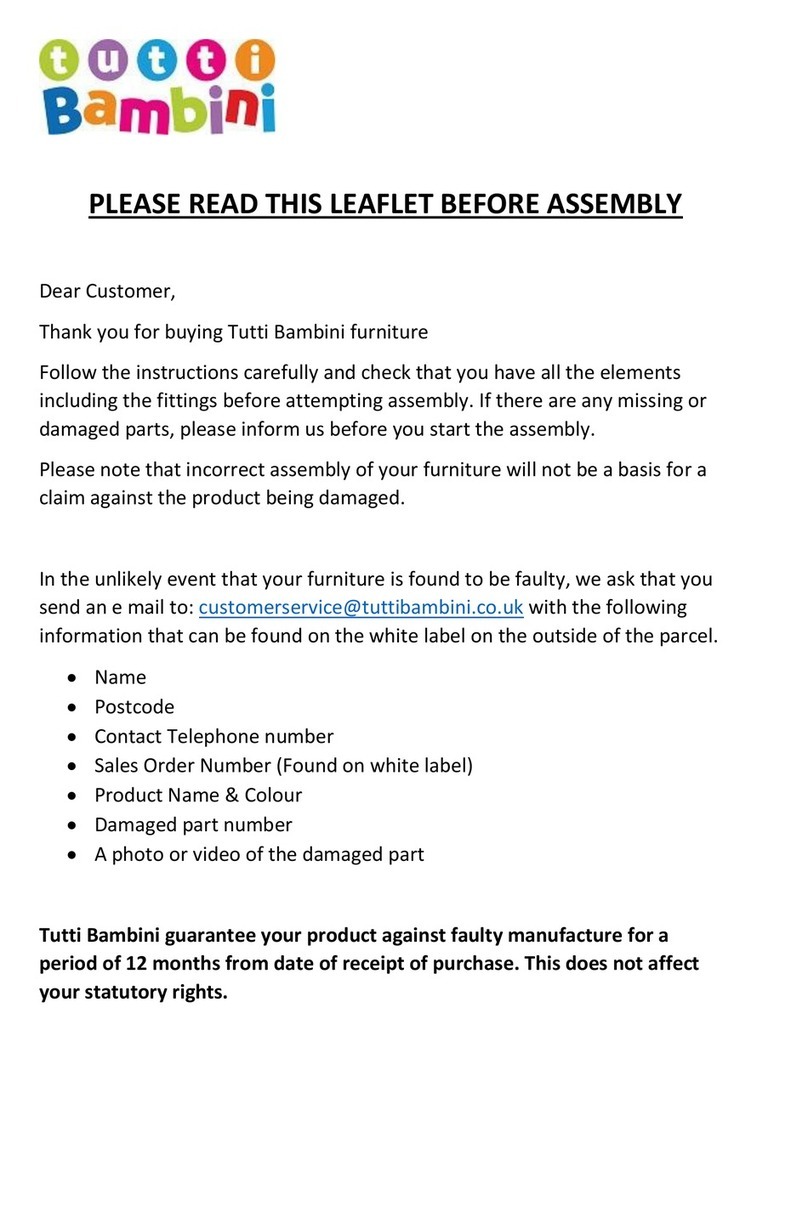
Tutti Bambini
Tutti Bambini TB10 ToyBox 211707 Assembly instruction
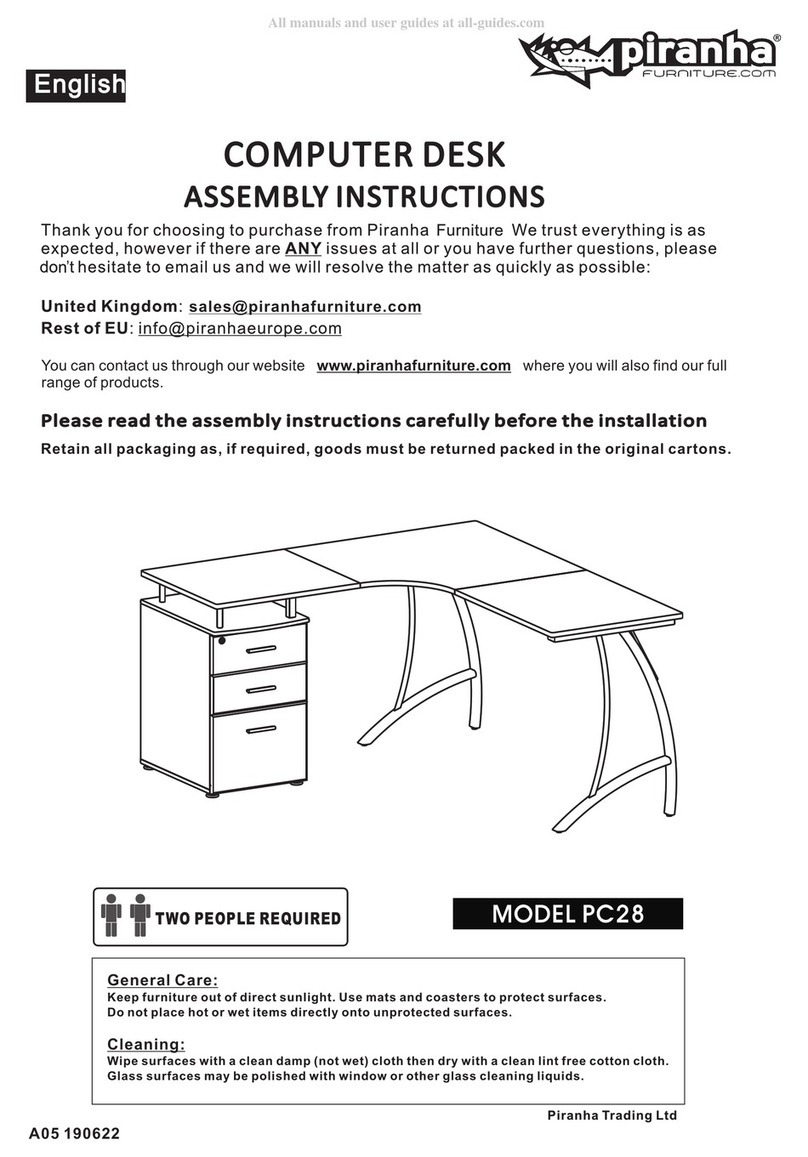
Piranha
Piranha PC28 Assembly instructions
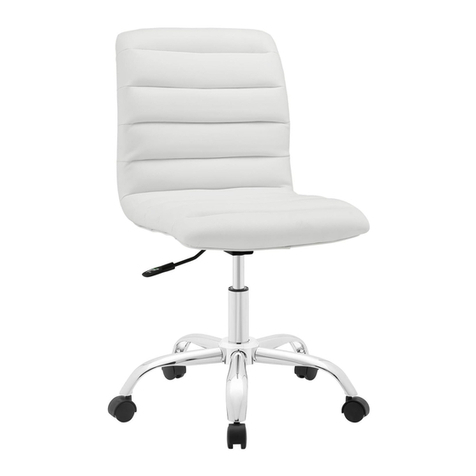
modway
modway Ripple EEI-1532 manual

Ballard Designs
Ballard Designs CASA Florentina Tarvine Double Pedestal Dining Table... Assembly instructions
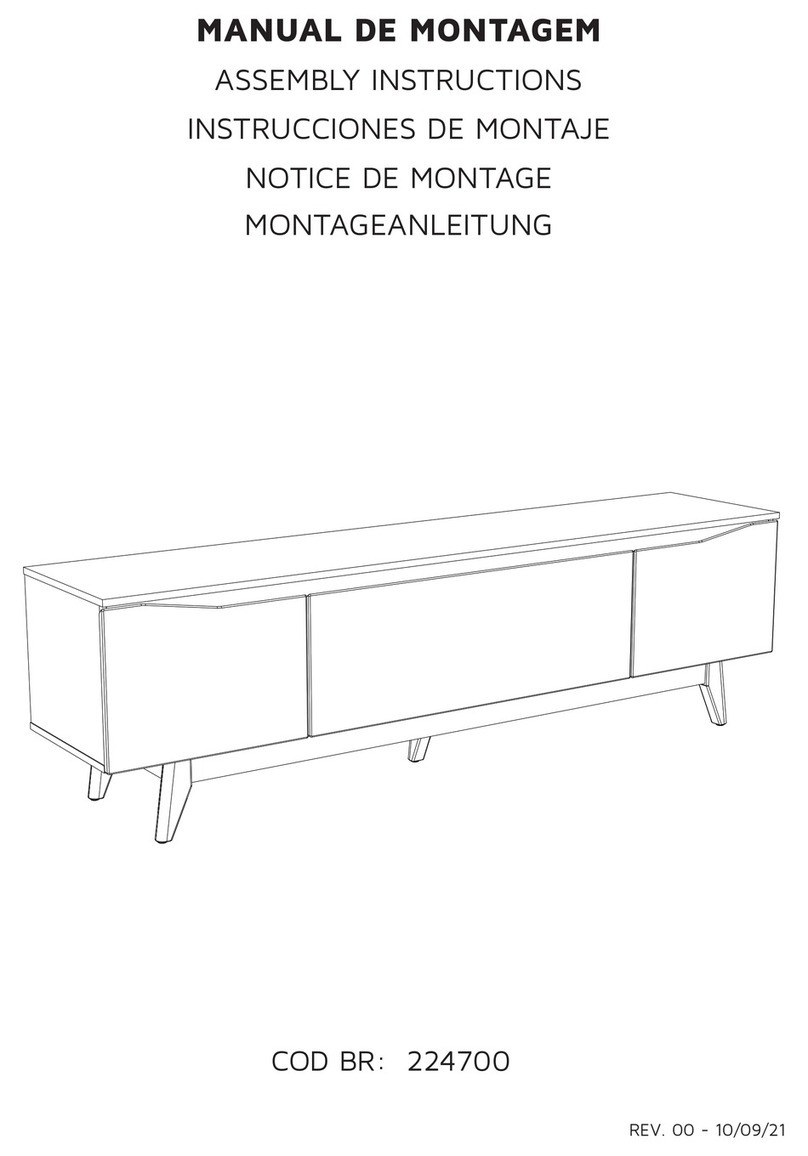
Decocasa
Decocasa 224700 Assembly instructions
